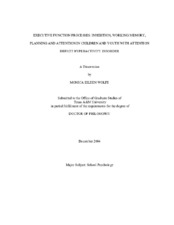| dc.description.abstract | This study examines the roles of inhibition, attention, working memory, and
planning in youth with and without ADHD. As conceptualized in theories of attention,
inhibition, and working memory, difficulties with these executive processes interact to
manifest in the behavioral syndrome(s) of ADHD. Barkley (1997) proposed disinhibition
as the primary deficit of ADHD. Rapport, Chung, Shore, Denney, & Isaacs, (2000)
theorized that ADHD results from a primary deficit in working memory. Mirsky (1987)
proposed a model of attention which children with ADHD have deficits in abilities to
focus/execute, encode and sustain attention. Posner and Petersen (1990) proposed that
three attentional networks are responsible for attentional processes and those children
with ADHD have deficits in the vigilance network. To investigate the contributions of
inhibition, working memory, attention, and planning in executive dysfunction in children
with ADHD, measures were selected from factor analytic studies.
Children with ADHD-Combined Type demonstrated poorer inhibition and
working memory than children with no diagnosis after controlling for IQ effects. No
differences in planning and attention were indicated after controlling for IQ effects.
However, a predictive discriminant analysis indicated that none of the executive
processes contributed to the prediction of group membership. Given correlational and
predictive discriminant analysis results, further analyses were conducted to investigate
the contribution of the measures selected for the domains. The theoretical model did not
represent a good fit of the data. A three-factor model indicated the best representation
suggesting that inhibition and attention were not separable. There were no group
differences with the revised measurement model for inhibition/attention, working
memory and planning. Taken together, results indicated measures originally selected to
tap executive function may not be clean measures of inhibition, working memory,
planning, or attention processes. In addition, recently proposed theories overlap and
conceptualize the multiple constructs involved in ADHD with a variety of
methodologies, further contributing to difficulties in interpreting results and
measurement issues. | en |


